Responses of Vegetation Growth to Climatic Factors in Shule River Basin in Northwest China: A Panel Analysis
Abstract
:1. Introduction
2. Overview of the Study Region
3. Data Sources and Methodology
3.1. Data Sources and Processing
3.2. Research Methodology
3.2.1. Linear Trend Analysis
3.2.2. Multiple Correlation Analysis
3.2.3. Mann–Kendall (M-K) Trend Detection
3.2.4. Panel Data Regression
4. Results
4.1. Quantity Characteristic of Vegetation Coverage
4.2. Spatial Characteristics of Vegetation Change
4.3. Correlation between Vegetation Variation and Climatic Factors
4.3.1. Multiple Correlation between Vegetation Variation and Climatic Factors
4.3.2. Trends of NDVI and Climatic Factors in a Year
4.4. Impact of Climatic Change on NDVI
4.4.1. The Overall Effect of the Panel Regression Models
4.4.2. Contribution of Climatic Change to NDVI
4.4.3. Individual-Specific Effect in Phase and Year
4.4.4. Coefficients Variation with Phase
5. Discussion and Conclusions
5.1. Discussion
5.2. Conclusions
Acknowledgments
Author Contributions
Conflicts of Interest
References
- De Jong, R.; de Bruin, S.; de Wit, A.; Schaepman, M.E.; Dent, D.L. Analysis of monotonic greening and browning trends from global NDVI time-series. Remote Sens. Environ. 2011, 115, 692–702. [Google Scholar] [CrossRef] [Green Version]
- Parmesan, C.; Yohe, G. A globally coherent fingerprint of climate change impacts across natural systems. Nature 2003, 421, 37–42. [Google Scholar] [CrossRef] [PubMed]
- Du, J.; Zhao, C.; Shu, J.; Jiaerheng, A.; Yuan, X.; Yin, J.; Fang, S.; He, P. Spatiotemporal changes of vegetation on the Tibetan Plateau and relationship to climatic variables during multiyear periods from 1982–2012. Environ. Earth Sci. 2016, 75, 1–18. [Google Scholar] [CrossRef]
- Fensholt, R.; Langanke, T.; Rasmussen, K.; Reenberg, A.; Prince, S.D.; Tucker, C.; Scholes, R.J.; Le, Q.B.; Bondeau, A.; Eastman, R.; et al. Greenness in semi-arid areas across the globe 1981–2007—An Earth Observing Satellite based analysis of trends and drivers. Remote Sens. Environ. 2012, 121, 144–158. [Google Scholar] [CrossRef]
- Tucker, C.J.; Newcomb, W.W.; Los, S.O.; Prince, S.D. Mean and inter-year variation of growing-season normalized difference vegetation index for the Sahel 1981–1989. Int. J. Remote Sens. 1991, 12, 1133–1135. [Google Scholar] [CrossRef]
- Myneni, R.B.; Hall, F.G. The interpretation of spectral vegetation indexes. IEEE Trans. Geosci. Remote. Sens. 1995, 33, 481–486. [Google Scholar] [CrossRef]
- Liu, Y.; Li, Y.; Li, S.; Motesharrei, S. Spatial and Temporal Patterns of Global NDVI Trends: Correlations with Climate and Human Factors. Remote Sens. 2015, 7, 13233–13250. [Google Scholar] [CrossRef]
- Wu, D.; Wu, H.; Zhao, X.; Zhou, T.; Tang, B.; Zhao, W.; Jia, K. Evaluation of Spatiotemporal Variations of Global Fractional Vegetation Cover Based on GIMMS NDVI Data from 1982 to 2011. Remote Sens. 2014, 6, 4217–4239. [Google Scholar] [CrossRef]
- De Jong, R.; Schaepman, M.E.; Furrer, R.; De Bruin, S.; Verburg, P.H. Spatial relationship between climatologies and changes in global vegetation activity. Glob. Chang. Biol. 2013, 19, 1953–1964. [Google Scholar] [CrossRef] [PubMed]
- Mao, J.; Shi, X.; Thornton, P.E.; Hoffman, F.M.; Zhu, Z.; Myneni, R.B. Global Latitudinal-Asymmetric Vegetation Growth Trends and Their Driving Mechanisms: 1982–2009. Remote Sens. 2013, 5, 1484–1497. [Google Scholar] [CrossRef]
- Sobrino, J.A.; Julien, Y. Global trends in NDVI-derived parameters obtained from GIMMS data. Int. J. Remote Sens. 2011, 32, 4267–4279. [Google Scholar] [CrossRef]
- Wang, X.; Piao, S.; Ciais, P.; Li, J.; Friedlingstein, P.; Koven, C.; Chen, A. Spring Temperature Change and Its Implication in the Change of Vegetation Growth in North America From 1982 to 2006. Proc. Natl. Acad. Sci. USA 2011, 108, 1240–1245. [Google Scholar] [CrossRef] [PubMed]
- Zhao, M.; Running, S.W. Drought-induced reduction in global terrestrial net primary production from 2000 through 2009. Science 2010, 329, 940–943. [Google Scholar] [CrossRef] [PubMed]
- Vicente-Serrano, S.M.; Cabello, D.; Tomás-burguera, M.; Martín-Hernández, N.; Beguería, S.; Azorin-Molina, C.; Kenawy, A.E. Drought Variability and Land Degradation in Semiarid Regions: Assessment Using Remote Sensing Data and Drought Indices (1982–2011). Remote Sens. 2015, 7, 4391–4423. [Google Scholar] [CrossRef]
- Gang, Y.; Hu, Z.; Chen, X.; Tashpolat, T. Vegetation dynamics and its response to climate change in Central Asia. J. Arid Land 2016, 8, 375–388. [Google Scholar]
- Li, Z.; Chen, Y.; Li, W.; Deng, H.; Fang, G. Potential impacts of climate change on vegetation dynamics in Central Asia. J. Geophys. Res. Atmos. 2015, 120, 2045–2057. [Google Scholar] [CrossRef]
- Mohammat, A.; Wang, X.; Xu, X.; Peng, L.; Yang, Y.; Zhang, X.; Mynenic, R.B.; Piao, S. Drought and spring cooling induced recent decrease in vegetation growth in Inner Asia. Agric. For. Meteorol. 2013, 178–179, 21–30. [Google Scholar] [CrossRef]
- Piao, S.; Wang, X.; Ciais, P.; Zhu, B.; Wang, T.; Liu, J. Changes in satellite-derived vegetation growth trend in temperate and boreal Eurasia from 1982 to 2006. Glob. Chang. Biol. 2011, 17, 3228–3239. [Google Scholar] [CrossRef]
- Dardel, C.; Kergoat, L.; Hiernaux, P.; Mougin, E.; Grippa, M.; Tucker, C.J. Re-greening Sahel: 30 years of remote sensing data and field observations (Mali, Niger). Remote Sens. Environ. 2014, 140, 350–364. [Google Scholar] [CrossRef]
- Donohue, R.J.; Mcvicar, T.R.; Roderick, M.L. Climate-related trends in Australian vegetation cover as inferred from satellite observations, 1981–2006. Glob. Chang. Biol. 2009, 15, 1025–1039. [Google Scholar] [CrossRef]
- Zhang, L.; Guo, H.; Wang, C.; Ji, L.; Li, J.; Wang, K.; Dai, L. The long-term trends (1982–2006) in vegetation greenness of the alpine ecosystem in the Qinghai-Tibetan Plateau. Environ. Earth Sci. 2014, 72, 1827–1841. [Google Scholar] [CrossRef]
- Sun, J.; Qin, X. Precipitation and temperature regulate the seasonal changes of NDVI across the Tibetan Plateau. Environ. Earth Sci. 2016, 75, 1–9. [Google Scholar] [CrossRef]
- Zhang, Y.; Peng, C.; Li, W.; Tian, L.; Zhu, Q.; Chen, H.; Fang, X.; Zhang, G.; Liu, G.; Mu, X.; et al. Multiple afforestation programs accelerate the greenness in the ‘Three North’ region of China from 1982 to 2013. Ecol. Indic. 2016, 61, 404–412. [Google Scholar] [CrossRef]
- Yuan, X.; Li, L.; Chen, X.; Shi, H. Effects of Precipitation Intensity and Temperature on NDVI-Based Grass Change over Northern China during the Period from 1982 to 2011. Remote Sens. 2015, 7, 10164–10183. [Google Scholar] [CrossRef]
- He, B.; Chen, A.; Wang, H.; Wang, Q. Dynamic Response of Satellite-Derived Vegetation Growth to Climate Change in the Three North Shelter Forest Region in China. Remote Sens. 2015, 7, 9998–10016. [Google Scholar] [CrossRef]
- Liu, S.; Gong, P. Change of surface cover greenness in China between 2000 and 2010. Chin. Sci. Bull. 2012, 57, 2835–2845. [Google Scholar] [CrossRef]
- Shen, Z.; Fu, G.; Yu, C.; Sun, W.; Zhang, X. Relationship between the Growing Season Maximum Enhanced Vegetation Index and Climatic Factors on the Tibetan Plateau. Remote Sens. 2014, 6, 6765–6789. [Google Scholar] [CrossRef]
- Xiao, J.; Zhou, Y.; Zhang, L. Contributions of natural and human factors to increases in vegetation productivity in China. Ecosphere 2015, 6, 1–20. [Google Scholar] [CrossRef]
- Li, H.; Li, Y.; Gao, Y.; Zou, C.; Yan, S.; Gao, J. Human Impact on Vegetation Dynamics around Lhasa, Southern Tibetan Plateau, China. Sustainability 2016, 8, 1146. [Google Scholar] [CrossRef]
- Liang, W.; Yang, Y.; Fan, D.; Guan, H.; Zhang, T.; Long, D.; Zhou, Y.; Bai, D. Analysis of spatial and temporal patterns of net primary production and their climate controls in China from 1982 to 2010. Agric. For. Meteorol. 2015, 204, 22–36. [Google Scholar] [CrossRef]
- Peng, S.; Chen, A.; Xu, L.; Cao, C.; Fang, J.; Myneni, R.B.; Pinzon, J.E.; Tucker, C.J.; Piao, S. Recent change of vegetation growth trend in China. Environ. Res. Lett. 2011, 6, 44027–44039. [Google Scholar] [CrossRef]
- Xu, G.; Zhang, H.; Chen, B.; Zhang, H.; Innes, J.L.; Wang, G.; Yan, J.; Zheng, Y.; Zhu, Z.; Myneni, R.B. Changes in Vegetation Growth Dynamics and Relations with Climate over China’s Landmass from 1982 to 2011. Remote Sens. 2014, 6, 3263–3283. [Google Scholar] [CrossRef]
- Liu, Y.; Lei, H. Responses of Natural Vegetation Dynamics to Climate Drivers in China from 1982 to 2011. Remote Sens. 2015, 7, 10243–10268. [Google Scholar] [CrossRef]
- Zhou, L.; Tucker, C.J.; Kaufmann, R.K.; Slayback, D.; Shabanov, N.V.; Myneni, R.B. Variations in northern vegetation activity inferred from satellite data of vegetation index during 1981 to 1999. J. Geophys. Res. Atmos. 2001, 106, 20069–20084. [Google Scholar] [CrossRef]
- Nemani, R.R.; Keeling, C.D.; Hashimoto, H.; Jolly, W.M.; Piper, S.C.; Tucker, C.J.; Myneni, R.B.; Running, S.W. Climate-Driven Increases in Global Terrestrial Net Primary Production from 1982 to 1999. Science 2003, 300, 1560–1563. [Google Scholar] [CrossRef] [PubMed]
- Herrmann, S.M.; Anyamba, A.; Tucker, C.J. Recent trends in vegetation dynamics in the African Sahel and their relationship to climate. Glob. Environ. Chang.-Hum. 2005, 15, 394–404. [Google Scholar] [CrossRef]
- Liu, L.; Zhao, X.; Chang, X.; Lian, J. Impact of Precipitation Fluctuation on Desert-Grassland ANPP. Sustainability 2016, 8, 1245. [Google Scholar] [CrossRef]
- Duan, H.; Yan, C.; Tsunekawa, A.; Song, X.; Li, S.; Xie, J. Assessing vegetation dynamics in the Three-North Shelter Forest region of China using AVHRR NDVI data. Environ. Earth Sci. 2011, 64, 1011–1020. [Google Scholar] [CrossRef]
- Han, K.S.; Park, Y.Y.; Yeom, J.M. Detection of change in vegetation in the surrounding Desert areas of Northwest China and Mongolia with multi-temporal satellite images. Asia-Pacific. J. Atmos. Sci. 2015, 51, 173–181. [Google Scholar]
- Lu, Y.; Zhang, L.; Feng, X.; Zeng, Y.; Fu, B.; Yao, X.; Li, J.; Wu, B. Recent Ecological Transitions in China: Greening, Browning, and Influential Factors. Sci. Rep. 2015, 5, 8732. [Google Scholar] [CrossRef] [PubMed]
- Yang, X.; Liu, S.; Yang, T.; Xu, X.; Kang, C.; Tang, J.; Wei, H.; Ghebrezgabher, M.G.; Li, Z. Spatial-temporal dynamics of desert vegetation and its responses to climatic variations over the last three decades: A case study of Hexi region in Northwest China. J. Arid Land 2016, 8, 556–568. [Google Scholar] [CrossRef]
- Wang, H.; Liu, G.; Li, Z.; Ye, X.; Wang, M.; Gong, L. Impacts of climate change on net primary productivity in arid and semiarid regions of China. Chin. Geogr. Sci. 2016, 26, 35–47. [Google Scholar] [CrossRef]
- De Jong, R.; Verbesselt, J.; Schaepman, M.E.; de Bruin, S. Trend changes in global greening and browning: Contribution of short-term trends to longer-term change. Glob. Chang. Biol. 2012, 18, 642–655. [Google Scholar] [CrossRef]
- Cihlar, J.; Ly, H.; Li, Z.; Chen, J.; Pokrant, H.; Huang, F. Multitemporal, multichannel AVHRR data sets for land biosphere studies—Artifacts and corrections. Remote Sens. Environ. 1997, 60, 35–57. [Google Scholar] [CrossRef]
- Jönsson, P.; Eklundh, L. TIMESAT—A program for analyzing time-series of satellite sensor data. Comput. Geosci. 2004, 30, 833–845. [Google Scholar] [CrossRef]
- Ding, M.; Zhang, Y.; Sun, X.; Liu, L.; Wang, Z.; Bai, W. Spatiotemporal variation in alpine grassland phenology in the Qinghai-Tibetan Plateau from 1999 to 2009. Chin. Sci. Bull. 2013, 58, 396–405. [Google Scholar] [CrossRef]
- Ma, M.; Frank, V. Interannual Variability of Vegetation Cover in the Chinese Heihe River Basin and Its Relation to Meteorological Parameters. Int. J. Remote Sens. 2006, 27, 3473–3486. [Google Scholar] [CrossRef]
- Song, Y.; Ma, M. A statistical analysis of the relationship between climatic factors and the Normalized Difference Vegetation Index in China. Int. J. Remote Sens. 2011, 45, 374–382. [Google Scholar] [CrossRef]
- Yue, S.; Pilon, P.; Phinney, B.; Cavadias, G. The influence of autocorrelation on the ability to detect trend in hydrological series. Hydrol. Process. 2002, 16, 1807–1829. [Google Scholar] [CrossRef]
- Yue, S.; Wang, C. The Mann-Kendall Test Modified by Effective Sample Size to Detect Trend in Serially Correlated Hydrological Series. Water Resour. Manag. 2004, 18, 201–218. [Google Scholar] [CrossRef]
- Gocic, M.; Trajkovic, S. Analysis of changes in meteorological variables using Mann-Kendall and Sen’s slope estimator statistical tests in Serbia. Glob. Planet. Chang. 2013, 100, 172–182. [Google Scholar] [CrossRef]
- Hsiao, C. Analysis of Panel Data, 2nd ed.; Cambridge University Press: New York, NY, USA, 2003; pp. 1–10. [Google Scholar]
- Mahadevan, R.; Asafu-Adjaye, J. Energy consumption, economic growth and prices: A reassessment using panel VECM for developed and developing countries. Energy Policy 2007, 35, 2481–2490. [Google Scholar] [CrossRef]
- Xu, W.; Liu, X. Response of Vegetation in the Qinghai-Tibet Plateau to Global Warming. Chin. Geogr. Sci. 2007, 17, 151–159. [Google Scholar] [CrossRef]
- Wu, D.; Zhao, X.; Liang, S.; Zhou, T.; Huang, K.; Tang, B.; Zhao, W. Time-lag effects of global vegetation responses to climate change. Glob. Chang. Biol. 2015, 21, 3520–3531. [Google Scholar] [CrossRef] [PubMed]
- Wang, H.; Chen, Y.; Li, W.; Deng, H. Runoff Responses to Climate Change in Arid Region of Northwestern China during 1960–2010. Chin. Geogr. Sci. 2013, 23, 286–300. [Google Scholar] [CrossRef]
- Deng, S.; Yang, T.; Zeng, B. Vegetation Cover Variation in the Qilian Mountains and its Response to Climate Change in 2000–2011. J. Mt. Sci. 2013, 10, 1050–1062. [Google Scholar] [CrossRef]
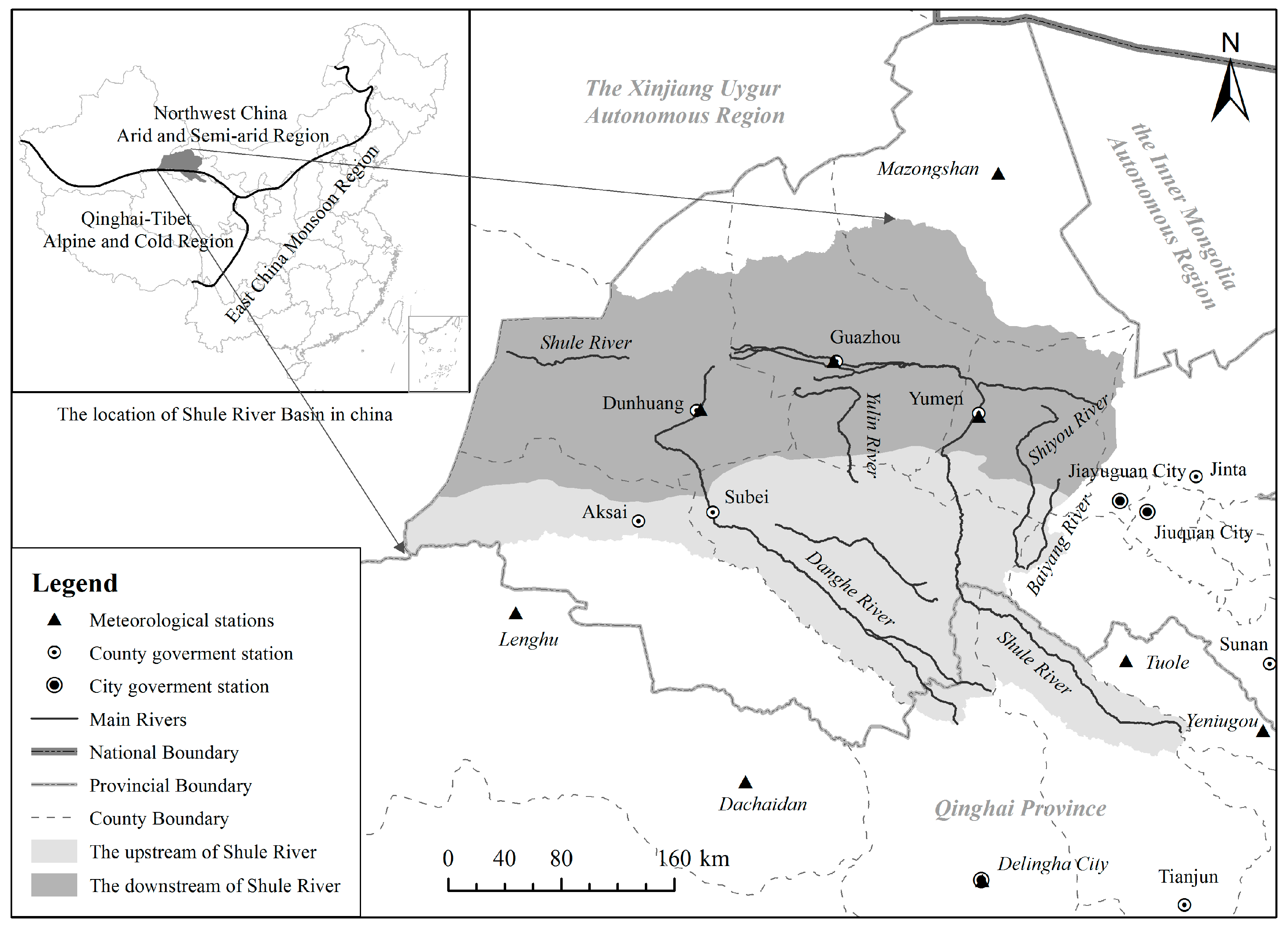



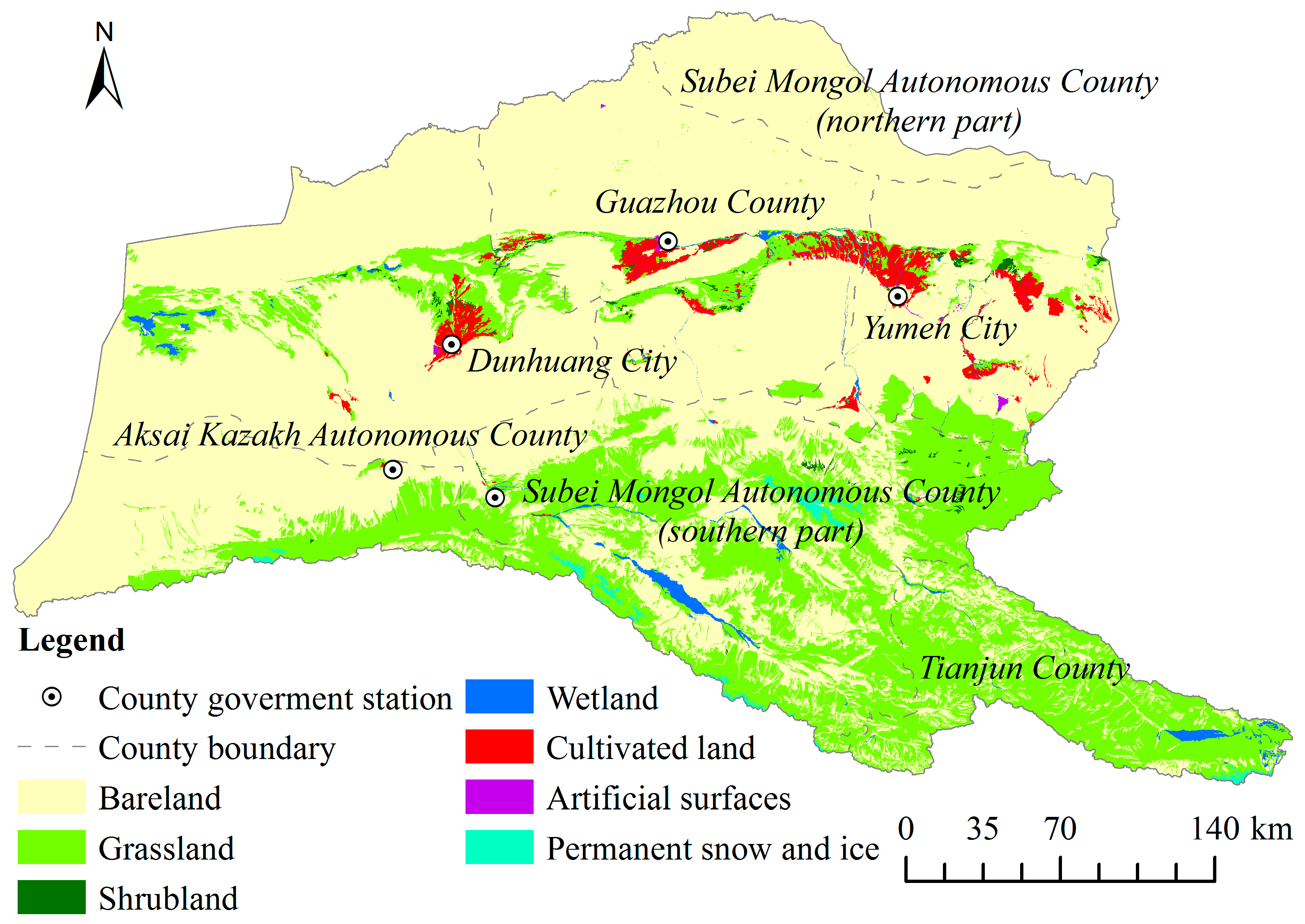
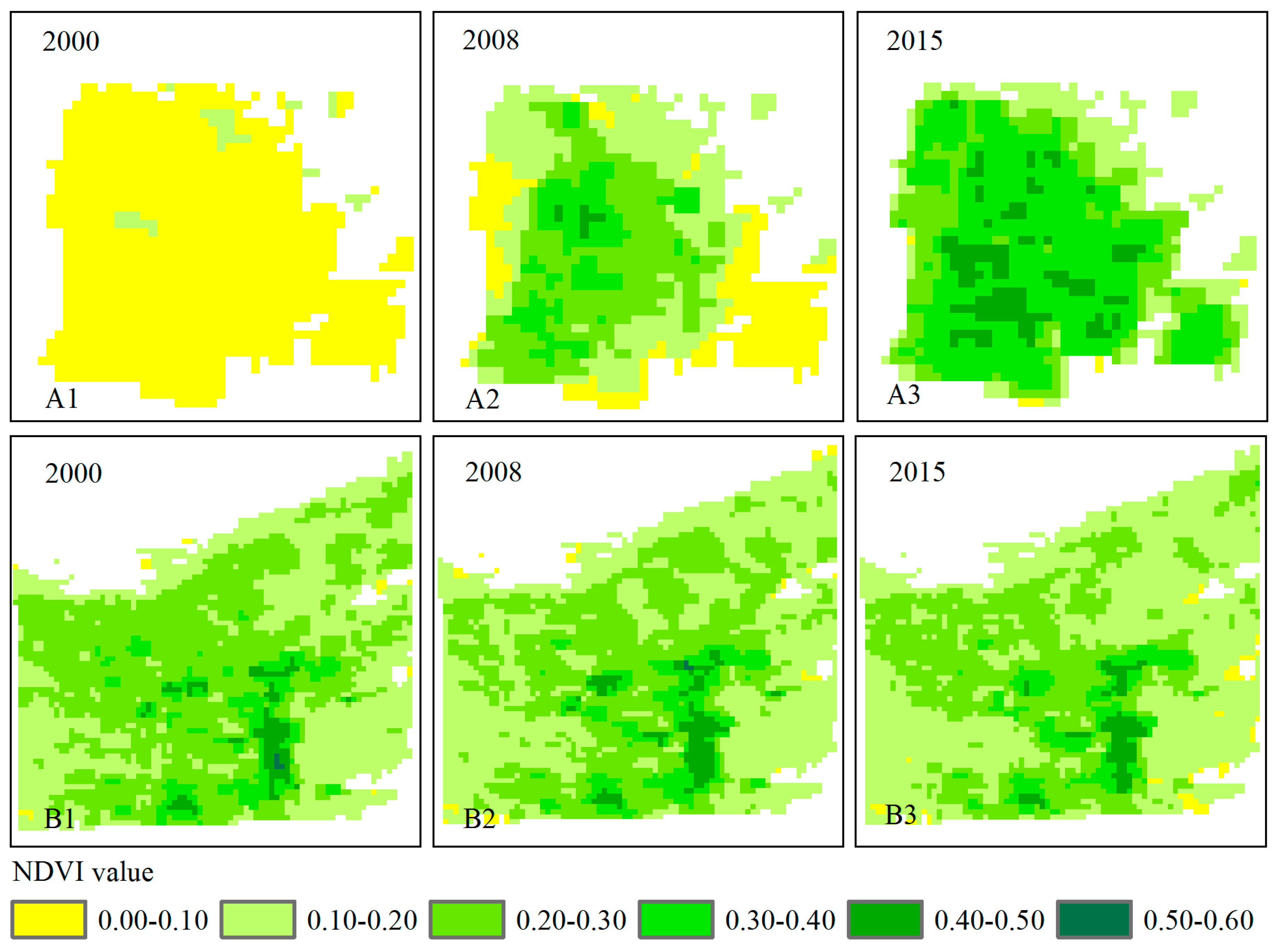
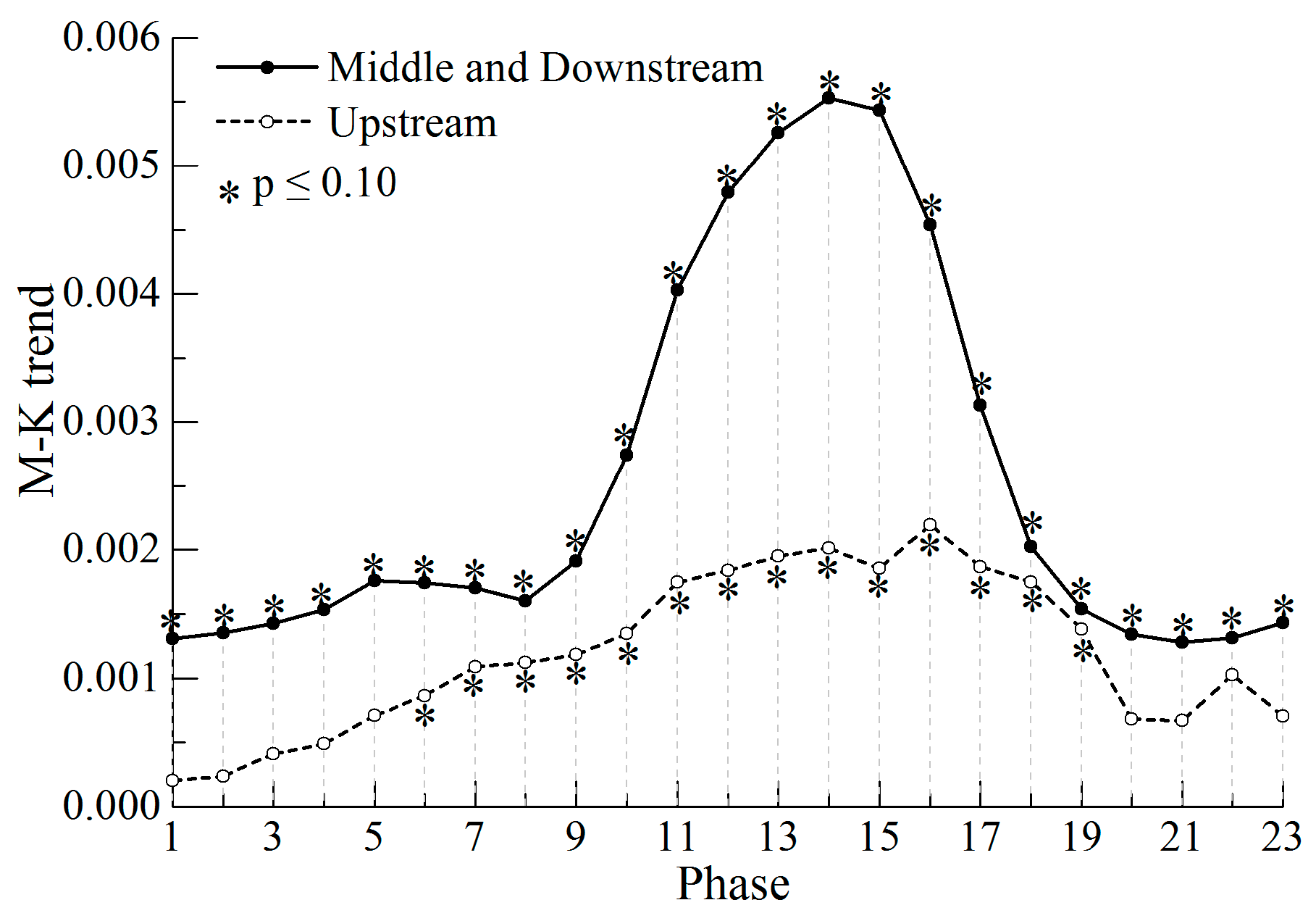
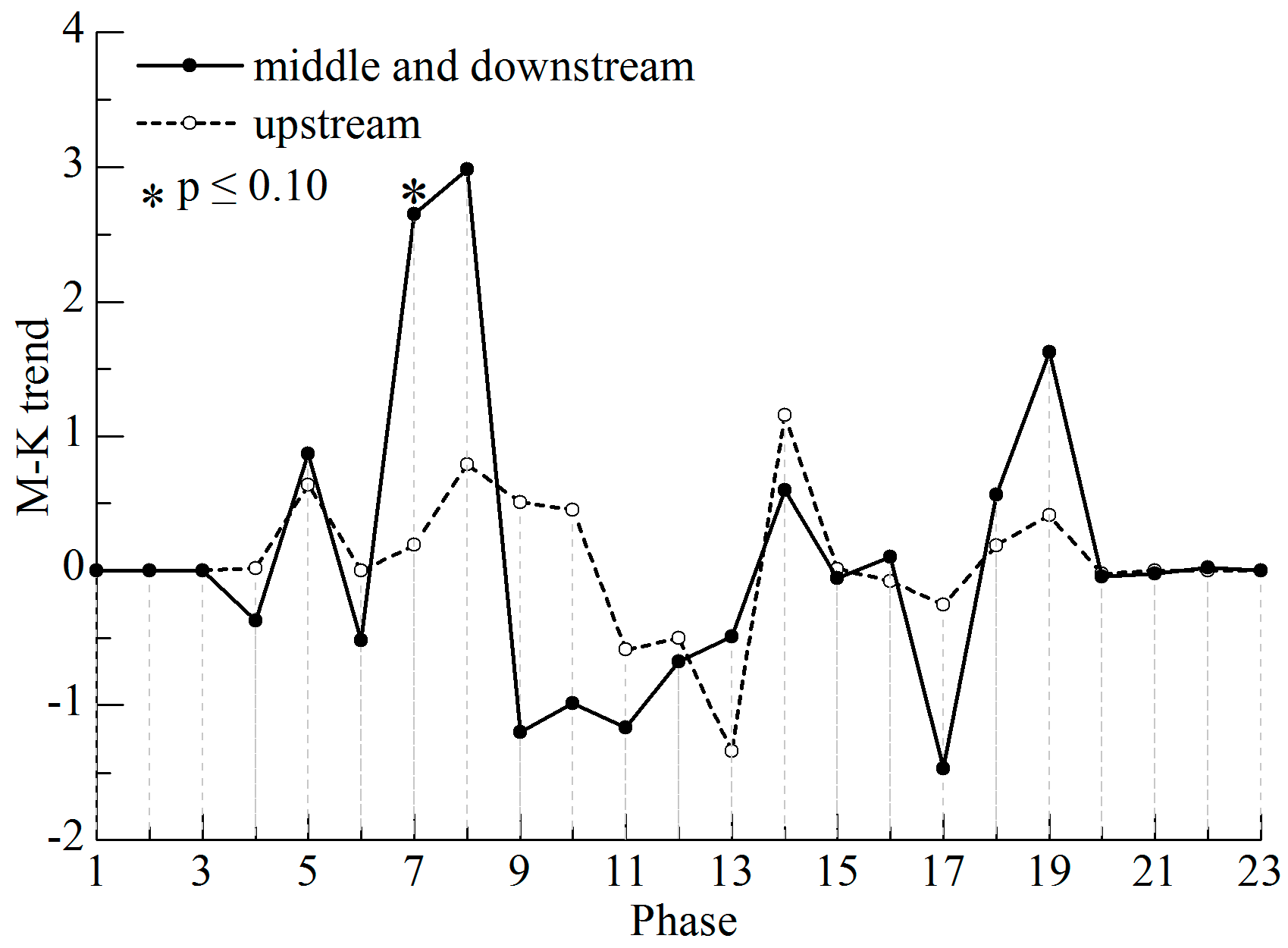
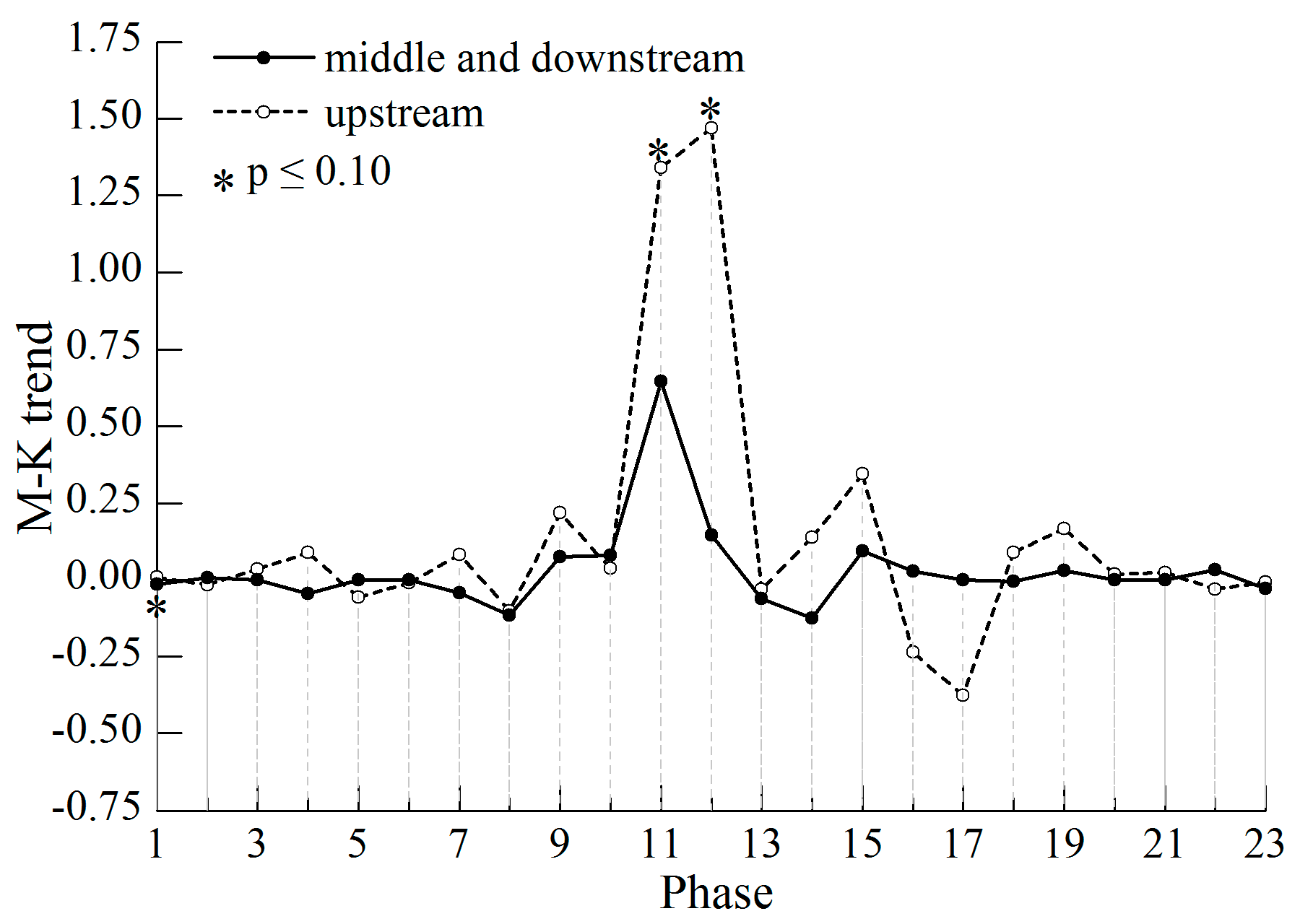
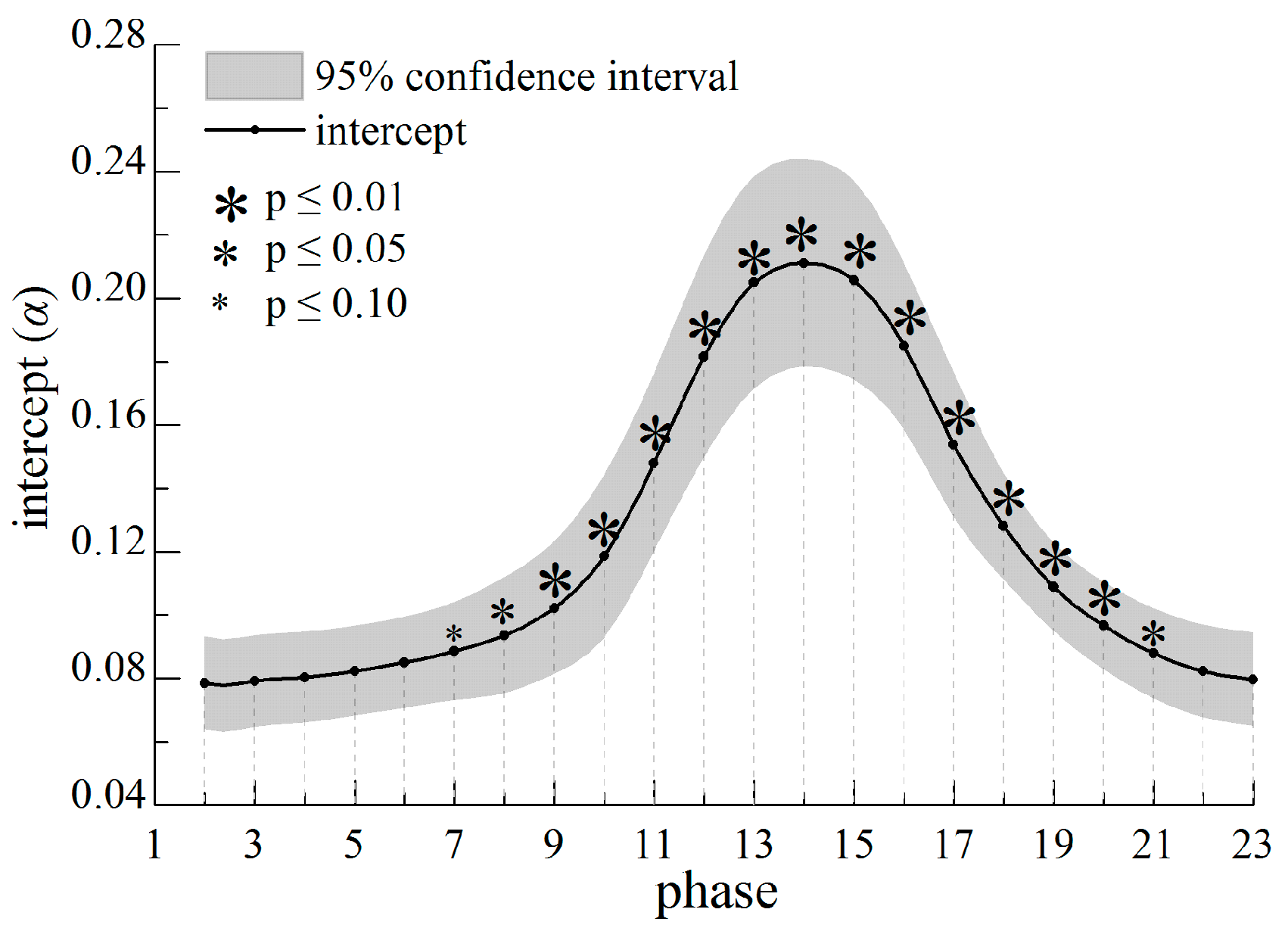
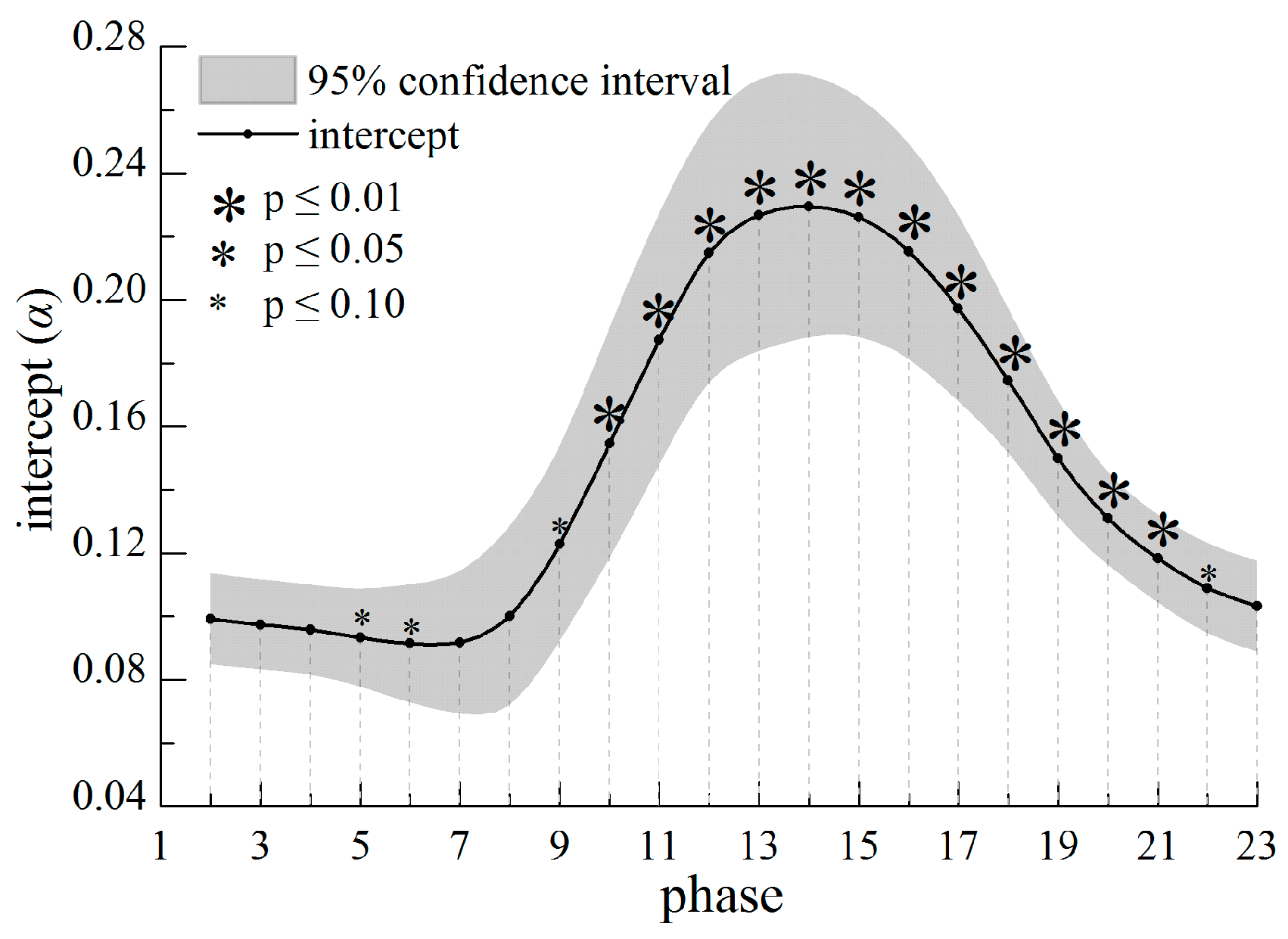
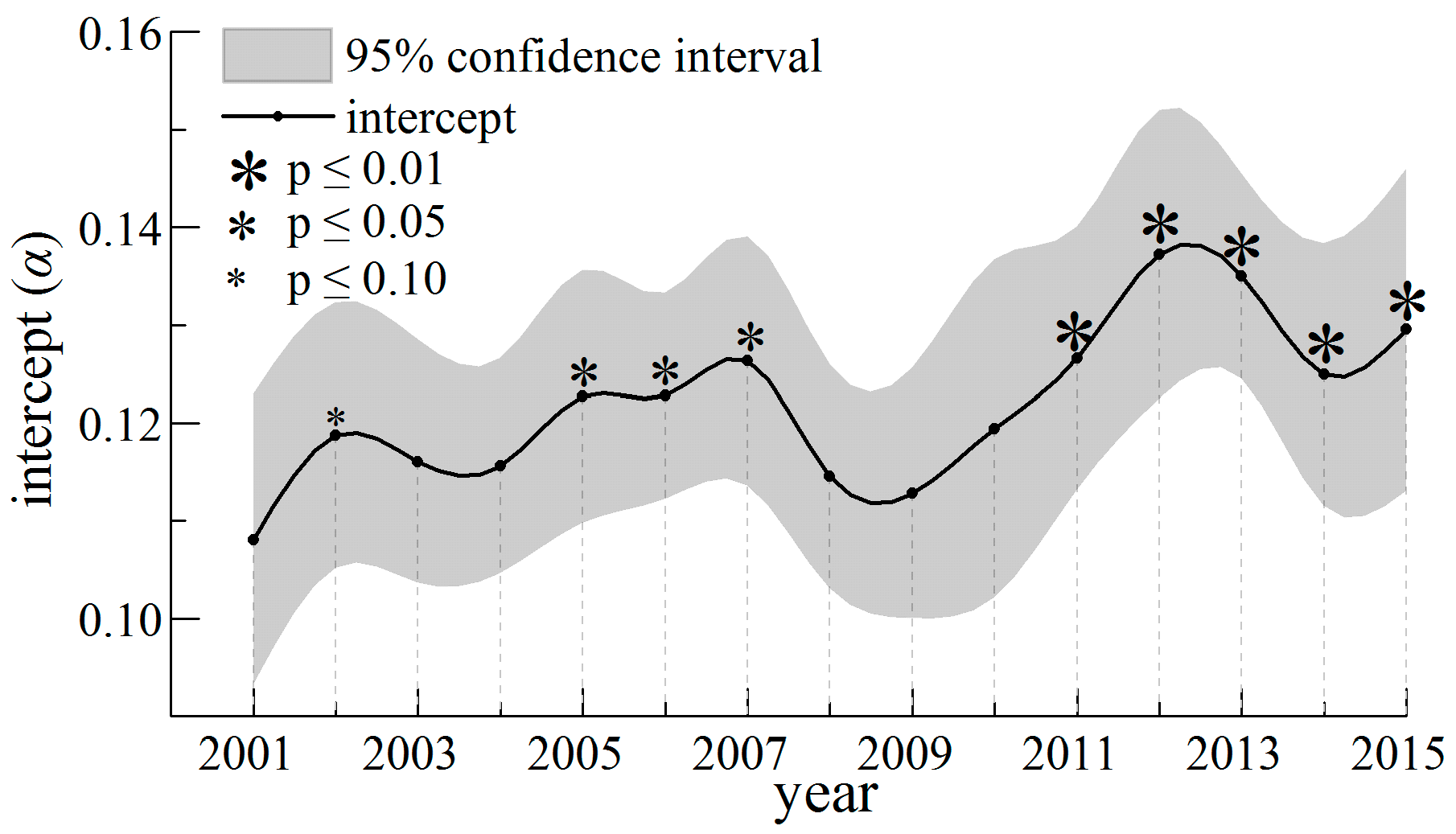
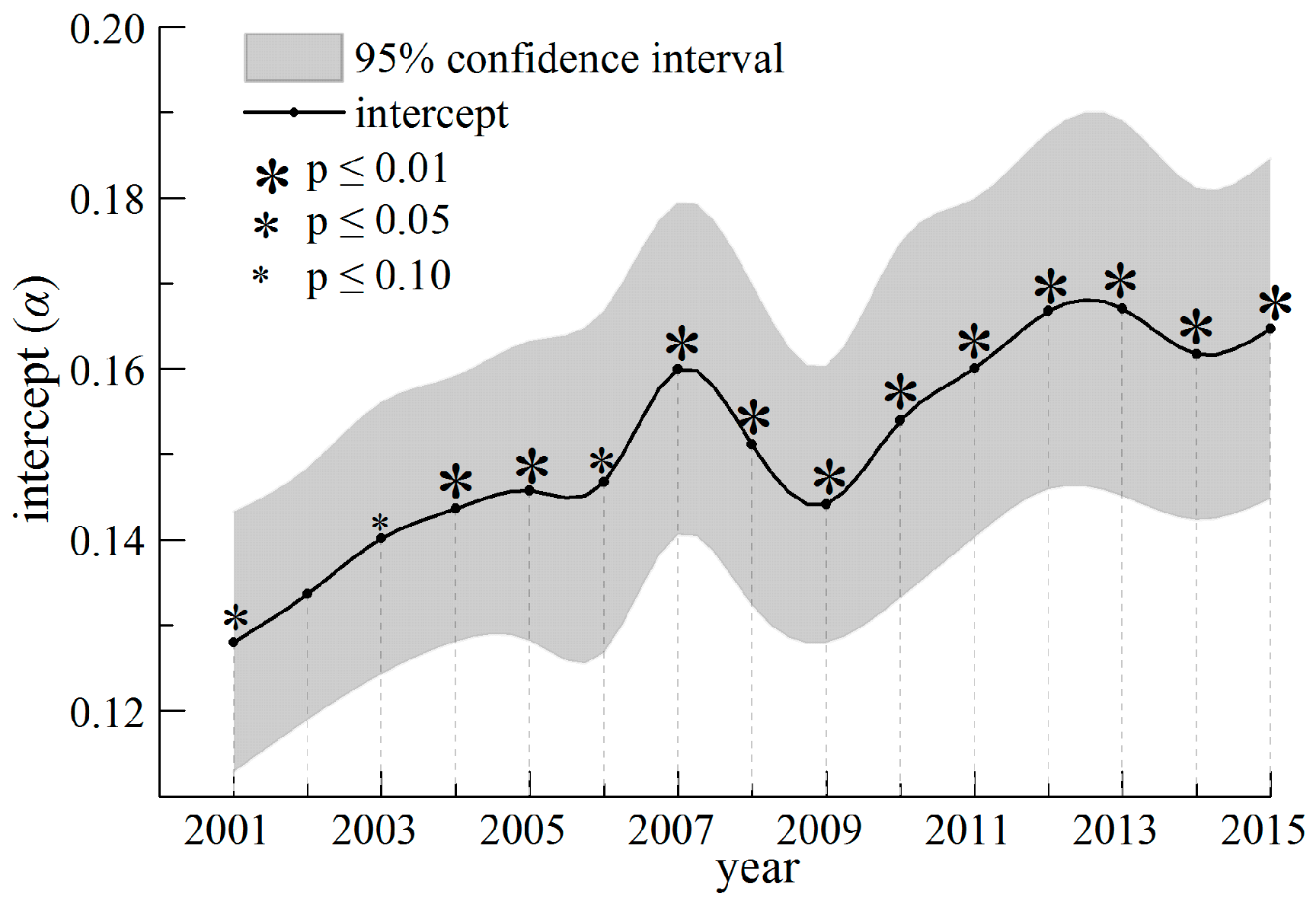
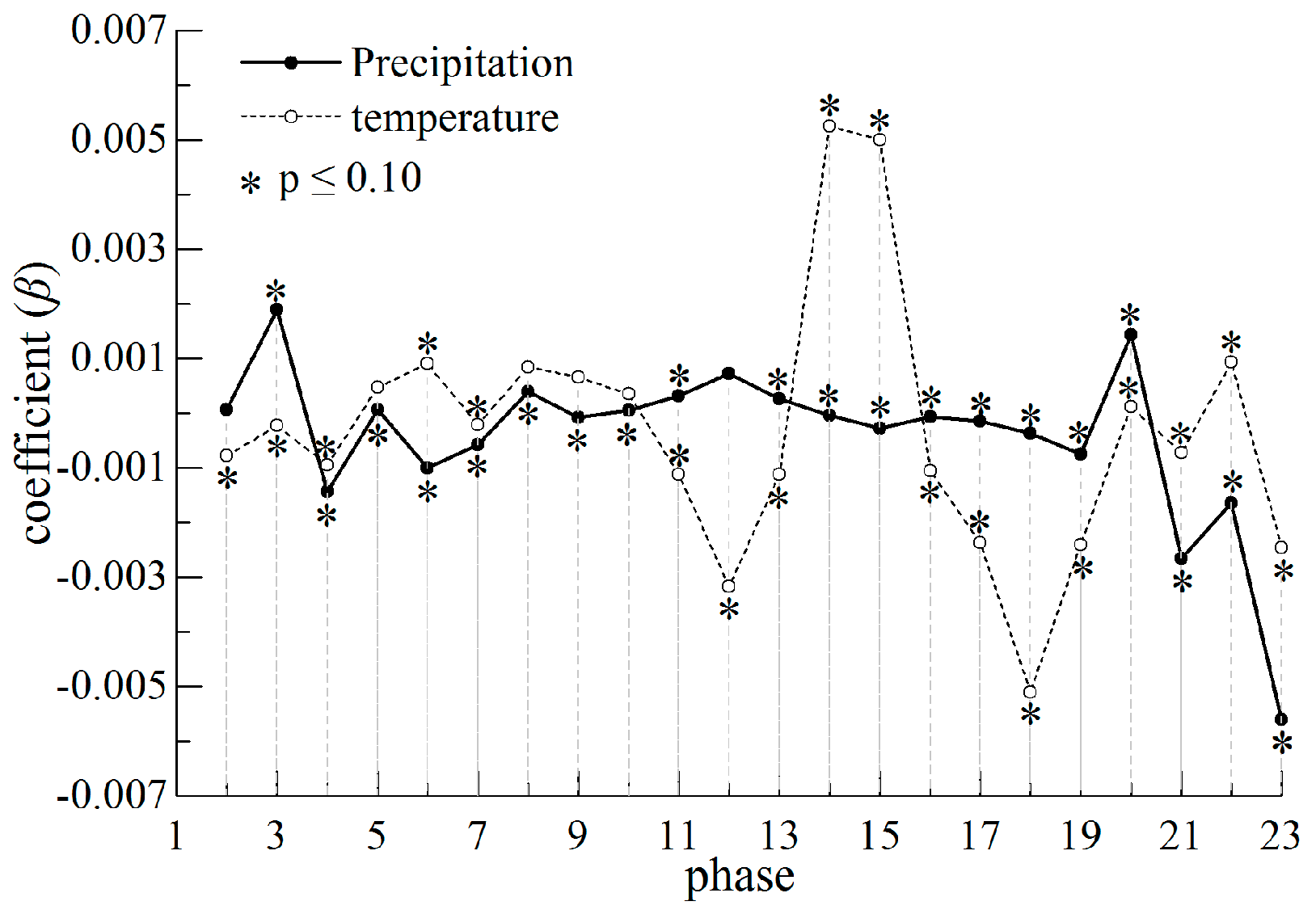
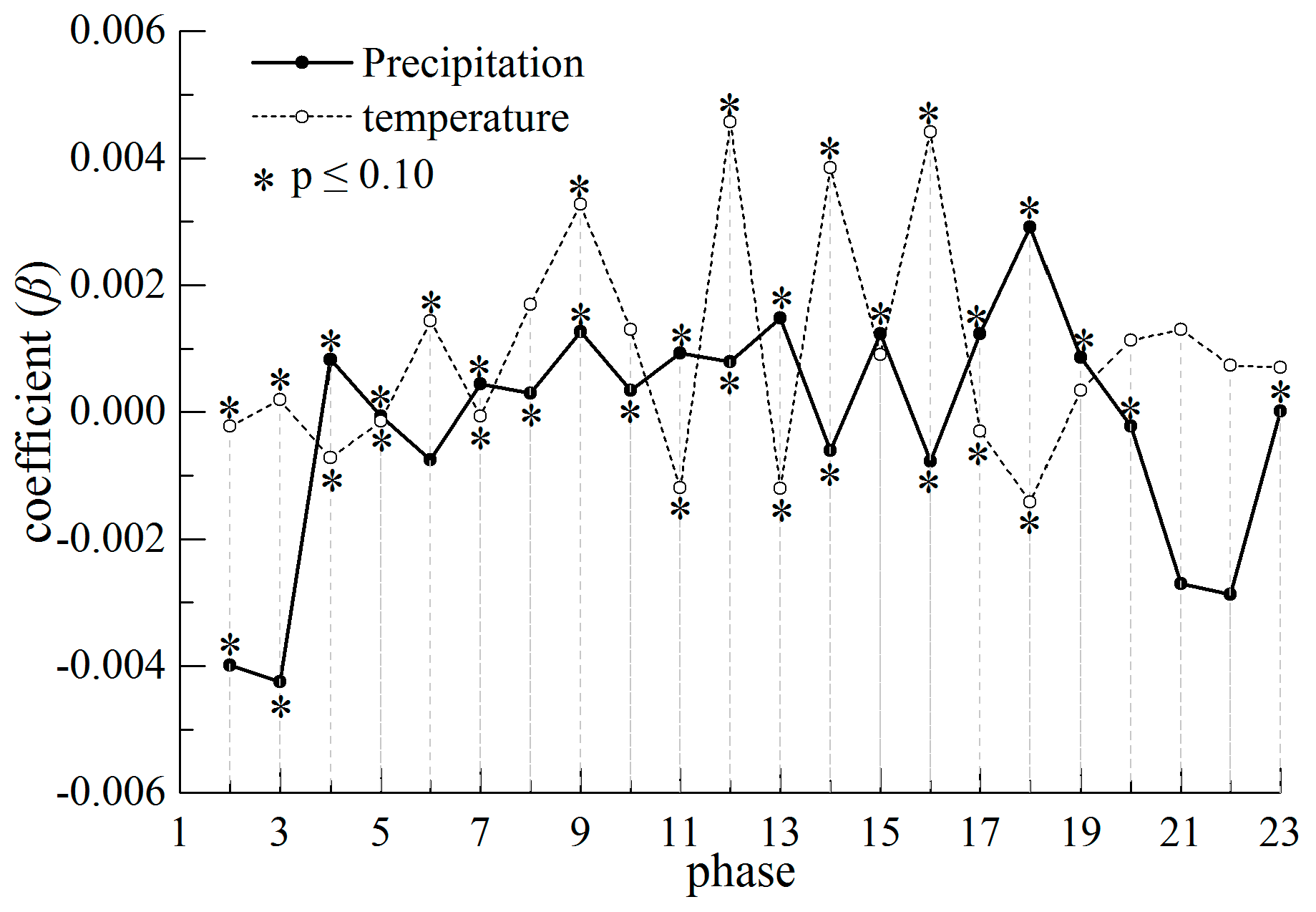
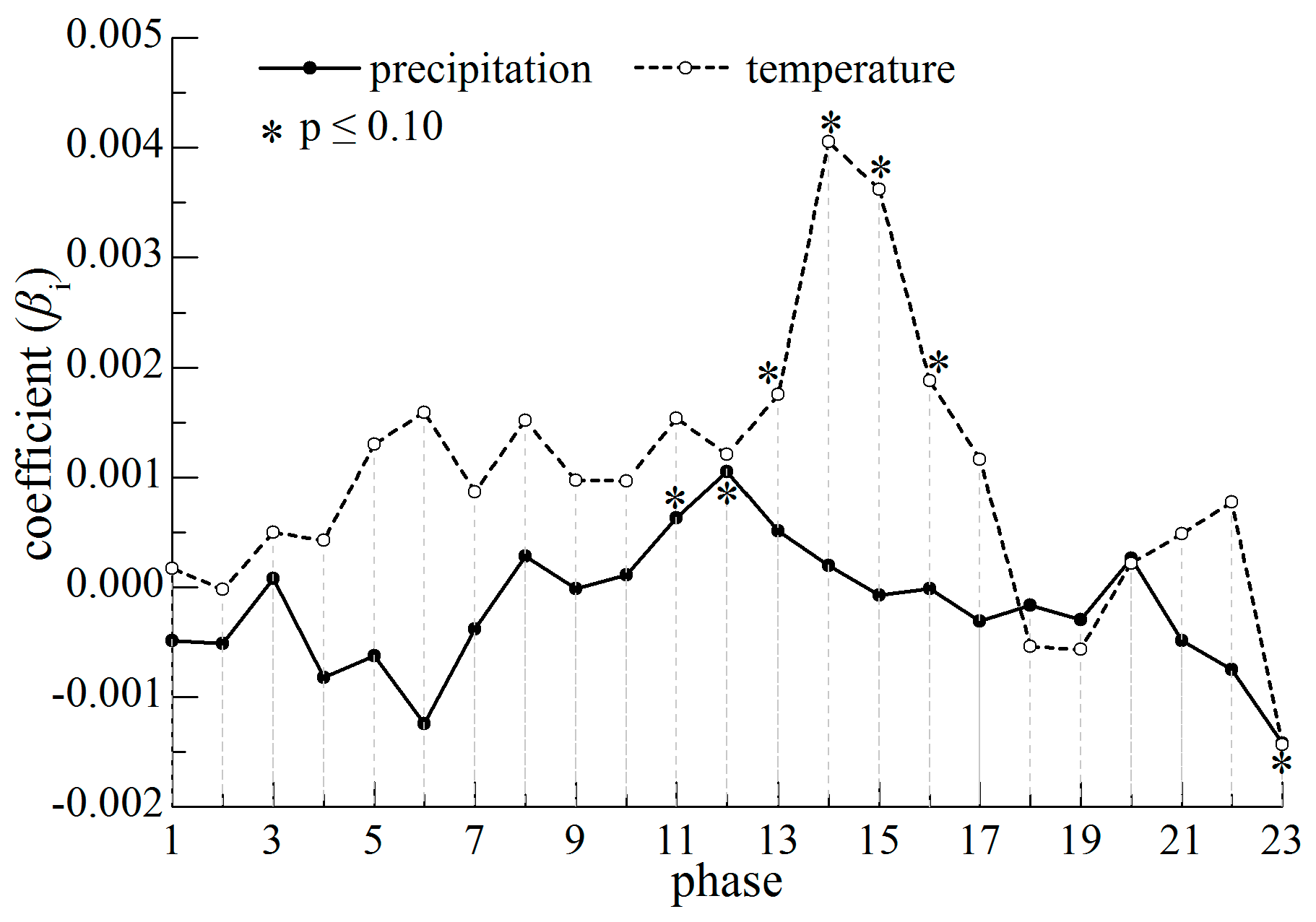
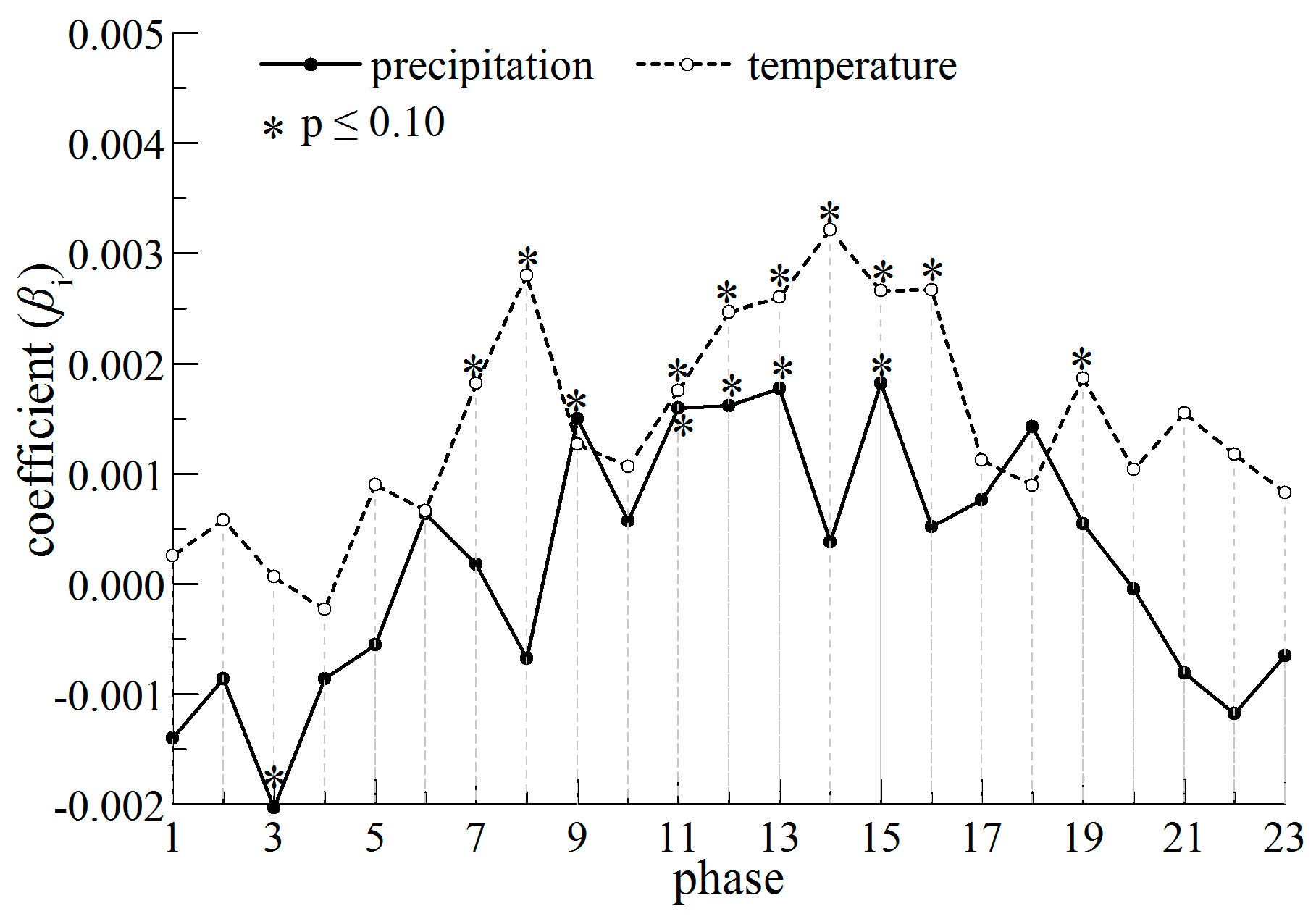
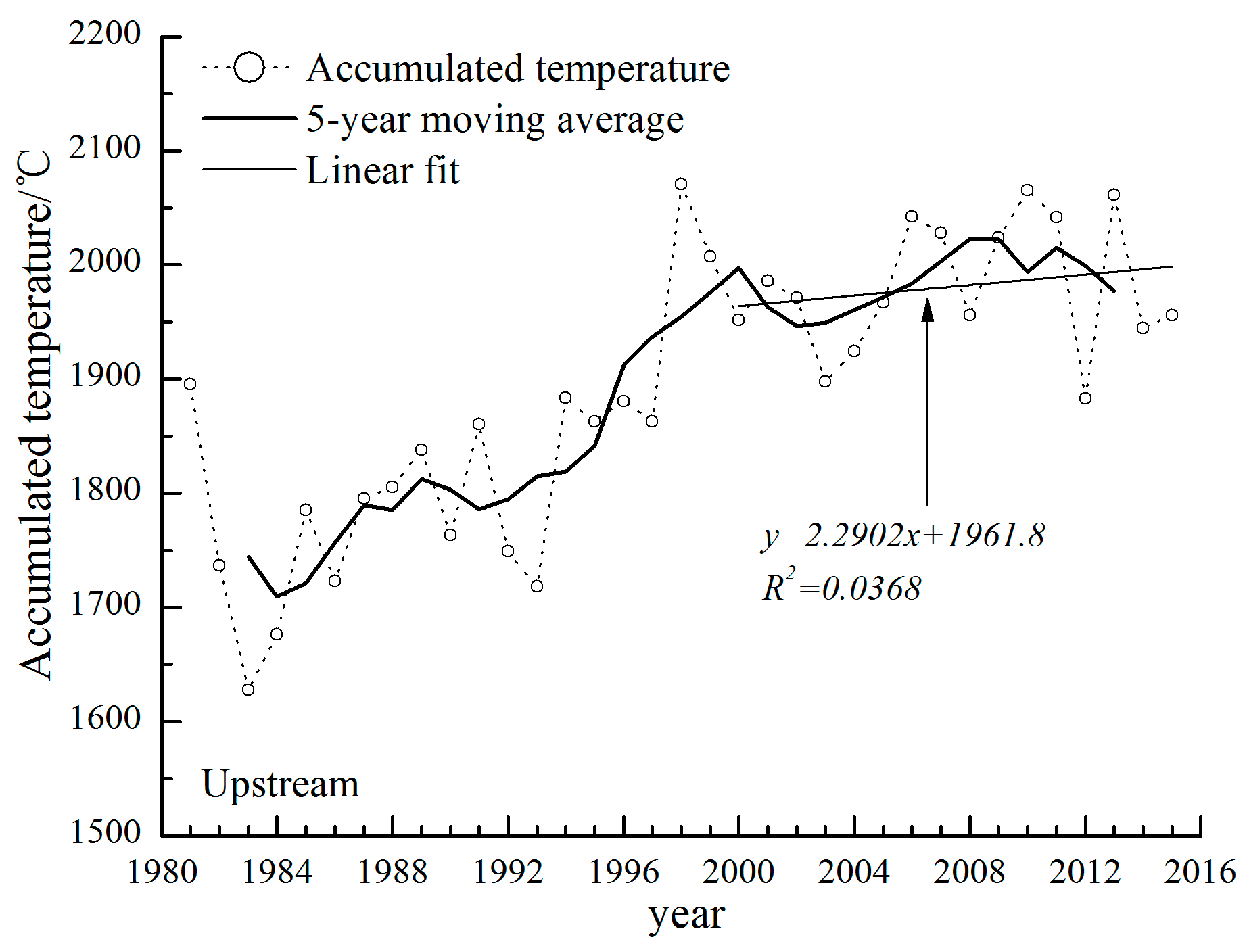
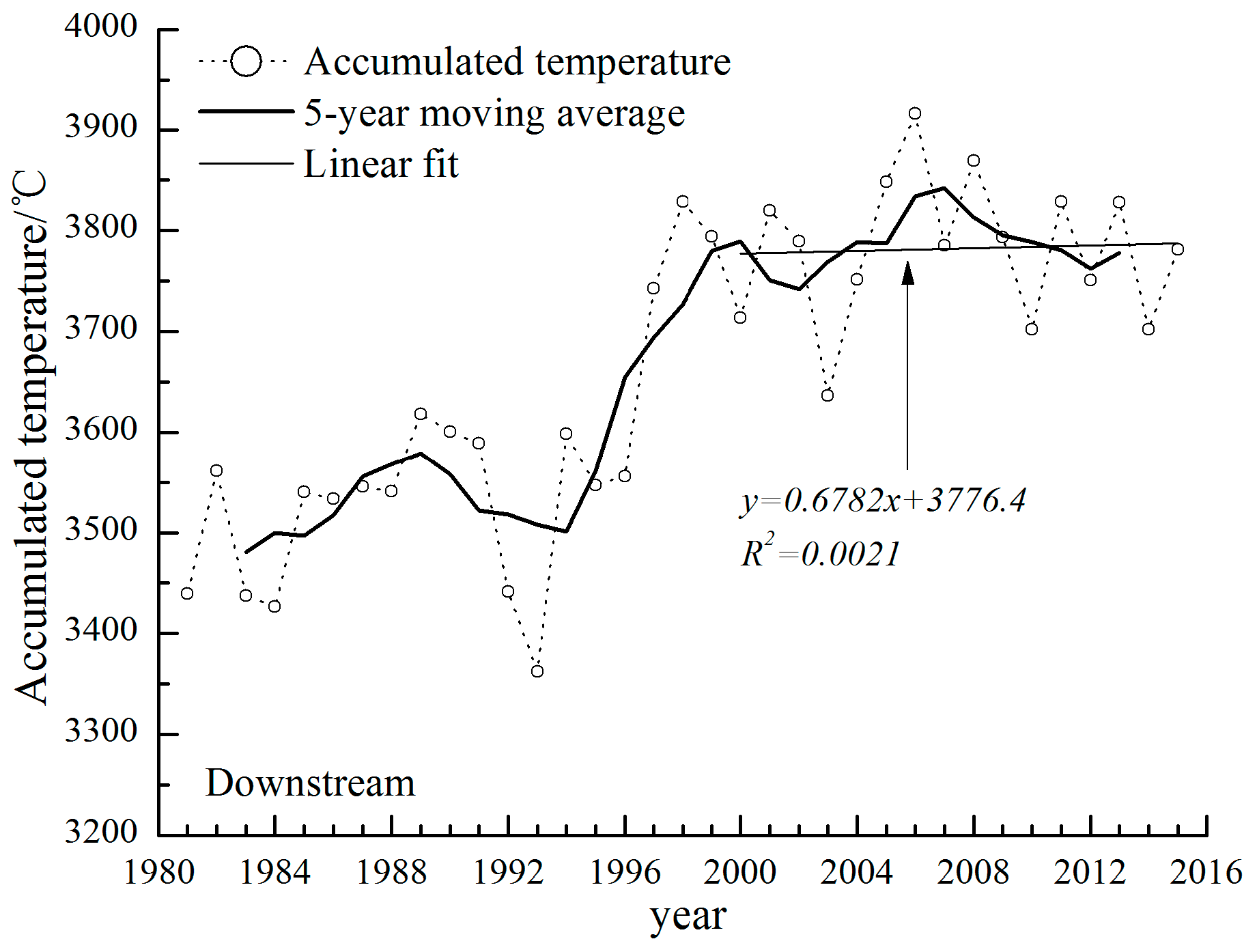

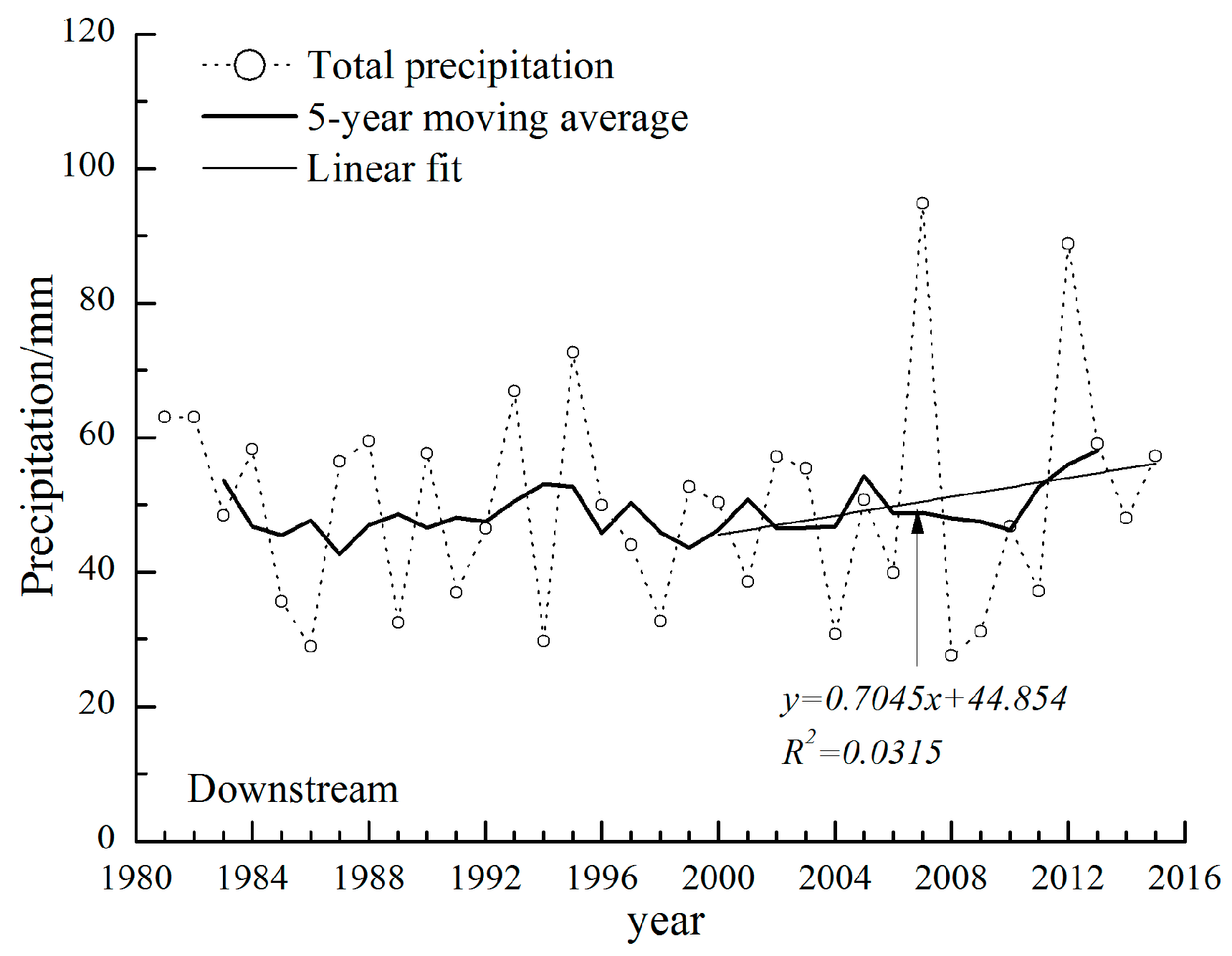
| NDVIgs Trends | High Significance p ≤ 0.01 | Significance 0.01 < p ≤ 0.1 | No Significance p > 0.1 | Summary |
|---|---|---|---|---|
| Moderate degradation (−0.03 < θ < −0.02) | 0.4363 | 0.5849 | 0.2585 | 1.2797 |
| Slight degradation (−0.02 ≤ θ < 0) | 0.0569 | 0.4376 | 5.4947 | 5.9892 |
| No change (θ = 0) | - | - | 0.0283 | 0.0283 |
| Slight improvement (0 < θ < 0.02) | 31.254 | 32.2391 | 28.7498 | 92.2429 |
| Moderate improvement (0.02 ≤ θ < 0.04) | 0.4597 | - | - | 0.4597 |
| High improvement (0.04 ≤ θ < 0.05) | 0.0002 | - | - | 0.0002 |
| Summary | 32.2071 | 33.2616 | 34.5313 | 100 |
| Degradation (θ < 0) | No Change (θ = 0) | Improvement (θ > 0) | Summary | |
|---|---|---|---|---|
| Guazhou | 1.41 | 0.00 | 5.88 | 7.29 |
| Dunhuang | 0.62 | 0.00 | 4.26 | 4.87 |
| Yumen | 0.97 | 0.00 | 9.09 | 10.06 |
| Tianjun | 3.09 | 0.01 | 15.84 | 18.94 |
| Subei (southern part) | 1.01 | 0.01 | 44.74 | 45.76 |
| Subei (northern part) | 0.14 | 0.00 | 4.03 | 4.17 |
| Aksai | 0.03 | 0.00 | 8.87 | 8.90 |
| Summary | 7.27 | 0.03 | 92.70 | 100.00 |
| Degradation (θ < 0) | No Change (θ = 0) | Improvement (θ > 0) | Summary | |
|---|---|---|---|---|
| Grassland | 4.27 | 0.02 | 48.94 | 53.23 |
| Shrubland | 0.11 | 0.00 | 0.74 | 0.86 |
| Wetland | 0.25 | 0.00 | 1.25 | 1.50 |
| Cultivated land | 0.99 | 0.00 | 4.32 | 5.31 |
| Bareland | 1.55 | 0.01 | 37.22 | 38.78 |
| Artificial surfaces | 0.10 | 0.00 | 0.21 | 0.30 |
| Permanent snow and ice | 0.00 | 0.00 | 0.02 | 0.02 |
| Summary | 7.27 | 0.03 | 92.70 | 100.00 |
| R | F-Statistic | Probability | ||
|---|---|---|---|---|
| Upstream | Current | 0.7984 | 8.7902 | 0.0063 |
| Lag phase 1 | 0.9680 | 74.4811 | 0.0000 | |
| Lag phase 2 | 0.9262 | 30.1908 | 0.0001 | |
| Lag phase 3 | 0.6934 | 4.6294 | 0.0377 | |
| Lag phase 4 | 0.4467 | 1.2463 | 0.3286 | |
| Downstream | Current | 0.6889 | 4.5157 | 0.0401 |
| Lag phase 1 | 0.9252 | 29.7200 | 0.0001 | |
| Lag phase 2 | 0.9809 | 126.9627 | 0.0000 | |
| Lag phase 3 | 0.8335 | 11.3765 | 0.0027 | |
| Lag phase 4 | 0.6313 | 3.3130 | 0.0787 |
| LLC | Breitung | IPS | Fisher | HT | ||
|---|---|---|---|---|---|---|
| NDVI | upstream | −8.0570 *** | −6.6448 *** | −5.7781 *** | −8.7002 *** | 0.1909 *** |
| downstream | −4.4107 *** | −1.5658 ** | −2.4993 *** | −2.4852 *** | 0.6760 *** | |
| Precipitation | upstream | −5.7606 *** | −9.4949 *** | −9.4238 *** | −5.1822 *** | −0.1524 *** |
| downstream | −7.7871 *** | −8.7712 *** | −8.3680 *** | −3.3978 *** | −0.0013 *** | |
| Accumulated temperature | upstream | −6.2357 *** | −7.3473 *** | −7.0134 *** | −6.1442 *** | −0.0515 *** |
| downstream | −5.9864 *** | −8.0651 *** | −8.1293 *** | −6.5662 *** | −0.0535 *** | |
| Temperature | upstream | −8.9307 *** | −6.7161 *** | −8.8995 *** | −6.2323 *** | −0.0939 *** |
| downstream | −7.4510 *** | −7.9551 *** | −8.6820 *** | −6.8601 *** | −0.1733 *** | |
| No. | Model | Cons | Pre | Atem | R2 | χ2 | F |
|---|---|---|---|---|---|---|---|
| 1 | OLS | 0.08029 *** (0.00164) | 0.00040 ** (0.00017) | 0.00047 *** (0.00002) | 0.8096 | 775.85 *** | |
| 2 | FE | 0.12000 *** (0.00527) | 0.00018 (0.00013) | 0.00003 (0.00006) | 0.8624 | 1.19 | |
| 3 | BE | 0.07961 *** (0.00566) | −0.00012 * (0.00168) | 0.00053 ** (0.00020) | 0.8697 | 66.76 *** | |
| 4 | LSDV | 0.07928 *** (0.00313) | 0.00018 (0.00014) | 0.00004 (0.00005) | 0.9447 | 170.13 *** | |
| 5 | FE_TW | 0.11352 *** (0.00377) | 0.00013 (0.00009) | 0.00002 (0.00004) | 0.8613 | 3669.19 *** | |
| 6 | RE | 0.09402 *** (0.00472) | 0.00030 *** (0.00010) | 0.00032 *** (0.00003) | 0.8690 | 115.50 *** | |
| 7 | FGLS | 0.09589 *** (0.00546) | 0.00035 ** (0.00016) | 0.00029 *** (0.00005) | 0.8687 | 54.28 *** | |
| 8 | MLE | 0.10613 *** (0.00889) | 0.00028 *** (0.00011) | 0.00018 *** (0.00006) | 13.92 *** | ||
| 9 | PCSE | 0.08308 *** (0.00283) | 0.00025 ** (0.00011) | 0.00048 *** (0.00001) | 0.8515 | 217.90 *** | |
| 10 | 2S-GMM | 0.11213 *** (0.00060) | 0.00028 *** (0.00003) | 0.00011 *** (0.000005) | 0.8096 | 446.47 *** |
| No. | Model | Cons | Pre | Atem | R2 | χ2 | F |
|---|---|---|---|---|---|---|---|
| 1 | OLS | 0.09791 *** (0.00269) | 0.00092 * (0.00047) | 0.00034 *** (0.00001) | 0.6993 | 424.33 *** | |
| 2 | FE | 0.14486 *** (0.00527) | 0.00071 ** (0.00027) | 0.00006* (0.00003) | 0.7460 | 7.27 *** | |
| 3 | BE | 0.09870 *** (0.01072) | −0.00182 (0.00732) | 0.00037 *** (0.00010) | 0.7527 | 30.44 *** | |
| 4 | LSDV | 0.10211 *** (0.00319) | 0.00071 ** (0.00029) | 0.00006 (0.00004) | 0.9379 | 175.24 *** | |
| 5 | FE-TW | 0.13509 *** (0.00476) | 0.00039** (0.00015) | 0.00003 (0.00002) | 0.7463 | 165.24 *** | |
| 6 | RE | 0.128991 *** (0.00724) | 0.00069 *** (0.00015) | 0.00016 *** (0.00002) | 0.7502 | 55.67 *** | |
| 7 | FGLS | 0.118130 *** (0.00650) | 0.00092 *** (0.00030) | 0.00022 (0.00003) | 0.7503 | 56.42 *** | |
| 8 | MLE | 0.12105 *** (0.01070) | 0.00090 *** (0.00024) | 0.00020 *** (0.00004) | 24.41 *** | ||
| 9 | PCSE | 0.10313 *** (0.00290) | 0.00081 *** (0.00016) | 0.00022 *** (0.00003) | 0.8162 | 68.87 *** | |
| 10 | 2S-GMM | 0.13437 *** (0.00635) | 0.00176 *** (0.00017) | 0.00008 ** (0.00004) | 187.51 *** |
| FE | RE | Difference | Std. Err. | |
|---|---|---|---|---|
| Constant | 0.1199954 | 0.958935 | 0.0241019 | - |
| Precipitation | 0.000175 | 0.0003507 | −0.0001757 | 0.0000291 |
| Temperature | 0.000035 | 0.000293 | −0.0002582 | 0.0000414 |
| Region | Constant (αi) | Precipitation (β0) | Temperature (β0) | χ2 (Wald) | χ2 (Test of Parameter Constancy) |
|---|---|---|---|---|---|
| Upstream | 0.112663 *** (0.011126) | −0.0001927 (0.000469) | 0.000979 (0.000687) | 2.33 | 1307.78 *** |
| Downstream | 0.134833 *** (0.012624) | 0.000188 0.0005347 | 0.001483 *** 0.0005626 | 6.53 ** | 2454.42 *** |
© 2017 by the authors. Licensee MDPI, Basel, Switzerland. This article is an open access article distributed under the terms and conditions of the Creative Commons Attribution (CC BY) license ( http://creativecommons.org/licenses/by/4.0/).
Share and Cite
Qi, J.; Niu, S.; Zhao, Y.; Liang, M.; Ma, L.; Ding, Y. Responses of Vegetation Growth to Climatic Factors in Shule River Basin in Northwest China: A Panel Analysis. Sustainability 2017, 9, 368. https://doi.org/10.3390/su9030368
Qi J, Niu S, Zhao Y, Liang M, Ma L, Ding Y. Responses of Vegetation Growth to Climatic Factors in Shule River Basin in Northwest China: A Panel Analysis. Sustainability. 2017; 9(3):368. https://doi.org/10.3390/su9030368
Chicago/Turabian StyleQi, Jinghui, Shuwen Niu, Yifang Zhao, Man Liang, Libang Ma, and Yongxia Ding. 2017. "Responses of Vegetation Growth to Climatic Factors in Shule River Basin in Northwest China: A Panel Analysis" Sustainability 9, no. 3: 368. https://doi.org/10.3390/su9030368





